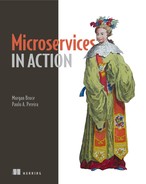Book Description
Microservices in Action teaches you how to write and maintain microservice-based applications. Created with day-to-day development in mind, this informative guide immerses you in real-world use cases from design to deployment. You’ll discover how microservices enable an efficient continuous delivery pipeline, and explore examples using Kubernetes, Docker, and Google Container Engine.
